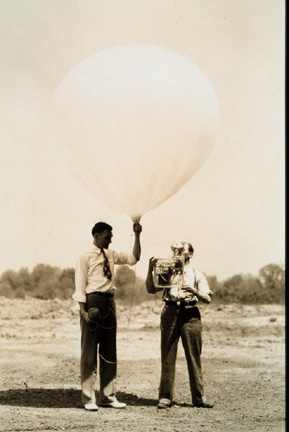radiosonde

Early launch of a radiosonde developed by the US Bureau of Standards at Washington, DC. Airport blimp hangar (7 May, 1936).
A radiosonde is a small box-like instrument that is carried into the upper atmosphere by balloon. As it travels upward, it transmits meteorological measurements to ground stations. Radiosondes measure temperature with a thermometer, humidity with a hygrometer, and air pressure with a barometer. Radiosondes are attached to helium-filled neoprene balloons that are designed to burst when they reach a specified altitude. They can operate up to around 100,000 feet (30,000 meters).
Radiosondes began to be used by investigators during the 1920s and 1930s and were in common use by the late 1930s. Their advantage over other types of meteorological instruments is that they do not have to be returned to Earth for their data to be retrieved.
Meteorologists send these instruments up into the upper atmosphere on balloons twice a day simultaneously around the world – at midnight and at noon Greenwich Mean Time (GMT). Radiosondes take continuous measurements as the balloon rises through the air. This information is transmitted by radio back to the ground. Special tracking equipment monitors the movement of the radiosonde, which is converted into wind speed and wind direction data. When the balloon bursts, the radiosonde falls back to Earth by parachute.


